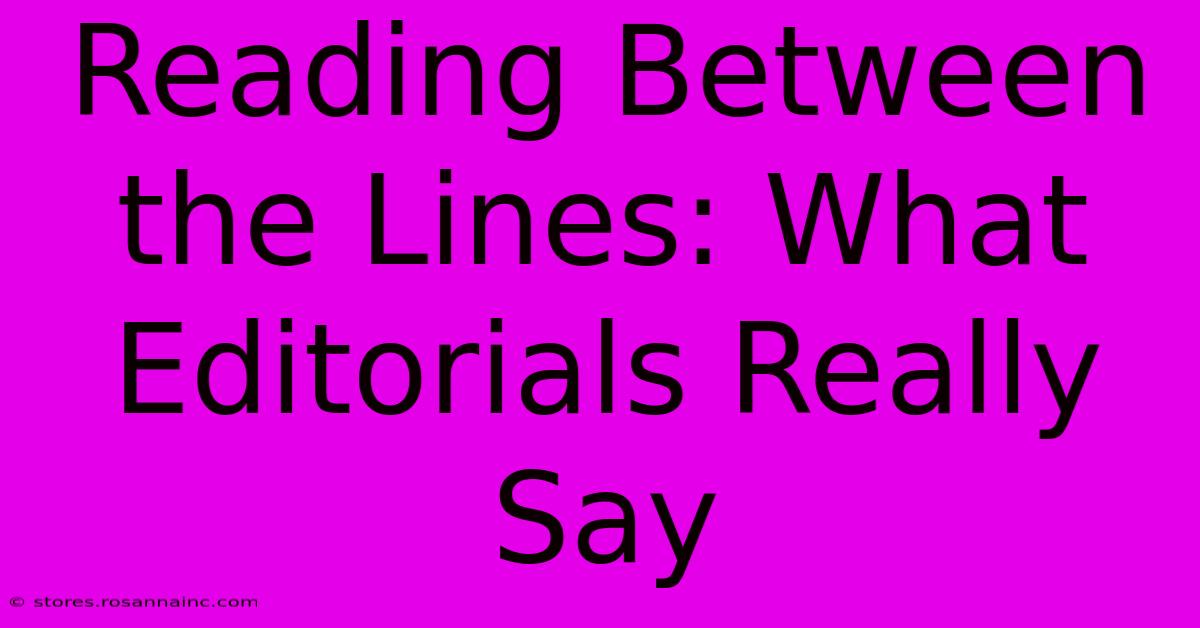Reading Between The Lines: What Editorials Really Say

Table of Contents
Reading Between the Lines: What Editorials Really Say
Editorials. Those opinion pieces nestled within news publications, often positioned prominently on the opinion page or website section. They're more than just someone's viewpoint; they're carefully crafted arguments designed to persuade you, the reader. But how can you truly understand what an editorial is really saying? This article will equip you with the tools to decipher the subtle nuances and underlying messages hidden within these persuasive pieces.
Beyond the Surface: Deconstructing Editorials
Editorials aren't just about stating an opinion; they're about advocating for a specific viewpoint. To understand their true message, we need to look beyond the surface-level claims and delve into the underlying strategies employed by the writers.
Identifying the Core Argument:
- The Thesis Statement: Every strong editorial has a central argument, often stated explicitly in the introduction or conclusion. This is the core message the writer wants you to accept. Identify this statement – it’s the bedrock of the entire piece.
- Supporting Evidence: How does the writer support their argument? Do they use facts, statistics, anecdotes, or expert opinions? Critically evaluate the quality and relevance of this evidence. Is it biased? Is it current and accurate? A lack of strong evidence is a red flag.
- Logical Fallacies: Be on the lookout for logical fallacies – flaws in reasoning that weaken the argument. Common fallacies include straw man arguments (misrepresenting the opposing viewpoint), appeals to emotion instead of logic, and false dilemmas (presenting only two options when more exist).
Understanding the Writer's Perspective:
- Identifying Bias: Every writer has a perspective, and it’s crucial to recognize it. Consider the publication's overall political leaning and the writer's potential affiliations. This will help you understand the context of the argument.
- Unstated Assumptions: What assumptions is the writer making? Are there underlying beliefs or values shaping their argument? Identifying these unstated assumptions can reveal the deeper motivations behind the editorial.
- Target Audience: Who is the intended audience for this editorial? Understanding the target audience can shed light on the writer's persuasive techniques and the overall message.
The Power of Language: Analyzing Rhetorical Devices
Editorials are masterclasses in persuasive writing, employing various rhetorical devices to influence the reader.
Recognizing Rhetorical Techniques:
- Appeals to Ethos, Pathos, and Logos: Editorials often utilize Aristotle's three modes of persuasion: ethos (credibility), pathos (emotion), and logos (logic). Identify how the writer uses each to build their case. A reliance on pathos over logos, for example, might indicate a less rigorous argument.
- Figurative Language: Metaphors, similes, and analogies are used to create vivid imagery and make complex ideas more accessible. Analyzing the figurative language can reveal the writer's underlying message and emotional tone.
- Tone and Word Choice: Pay close attention to the writer's tone – is it sarcastic, indignant, hopeful, or concerned? The choice of words significantly impacts the overall message and the reader's perception.
Beyond the Editorial: Further Research
After critically analyzing an editorial, consider expanding your understanding by:
- Seeking Diverse Perspectives: Read editorials from different publications with contrasting viewpoints. This will give you a more balanced understanding of the issue.
- Verifying Information: Check the facts and figures presented in the editorial against reputable sources. Independent verification is crucial for informed decision-making.
- Understanding the Context: Consider the broader social, political, and economic context surrounding the issue discussed in the editorial. This provides valuable background information for a more nuanced interpretation.
By mastering these techniques, you'll transform from a passive reader into an active interpreter of editorials, capable of discerning the true message beyond the surface-level arguments. You'll be empowered to form your own informed opinions based on a deeper understanding of the persuasive techniques at play. You will become a more critical and informed citizen.

Thank you for visiting our website wich cover about Reading Between The Lines: What Editorials Really Say. We hope the information provided has been useful to you. Feel free to contact us if you have any questions or need further assistance. See you next time and dont miss to bookmark.
Featured Posts
-
Naves Vs Gueret Federale 3 Ce Dimanche
Feb 09, 2025
-
Beyond The Book Exploring The Magic Of My Side Of The Mountain
Feb 09, 2025
-
Conquering Complex Data With The Generalized Method Of Moments
Feb 09, 2025
-
Six Nations Rugby England Vs France Live
Feb 09, 2025
-
Estas Listo Para Pagar El Precio De Amarte
Feb 09, 2025
